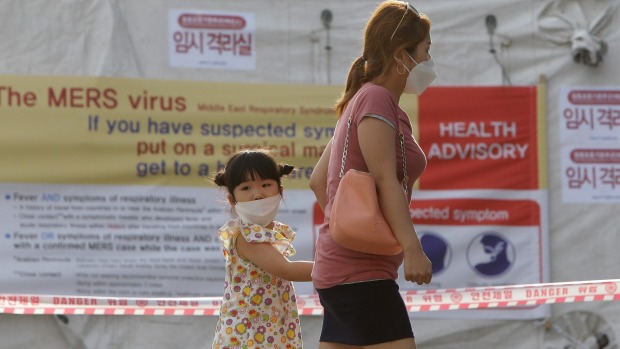
Visitors wearing masks walk in front of a health advisory sign at a quarantine tent at Seoul National University Hospital. Photo: Chung Sung-Jun
- Seoul: At first, doctors thought the 68-year-old man might have simple pneumonia. He coughed and wheezed his way through three hospitals before officials figured out that he had something far more serious and contagious.
Along the way, health officials said the man has infected dozens who became potential carriers and infected dozens more and counting.

Airport guards wear masks as a precaution against the MERS virus at the Incheon International Airport on on the weekend. Photo: Chung Sung-Jun
Now South Korea’s emergency rooms, known to cram seats and beds closely together, and system that allows patients to ‘hospital shop’ are being blamed for the quick spread of the virus.
The original diagnosis that missed what became South Korea’s first case of Middle East respiratory syndrome, or MERS, was possibly caused by incomplete information from the patient about his travels. The World Health Organisation acknowledged that MERS was not an easy virus to identify early because its symptoms are similar to other respiratory infections, like a common cold.
But it was especially problematic in South Korea because of peculiarities in the hospital system, health experts said on Monday.
Patients jostle, cajole and name-drop to get referrals into the biggest hospitals, which they believe attract the best doctors. Family members and outside caregivers commingle with the sick in crowded emergency wards. They often stay with the patients in their rooms and do much of the nursing work, exposing themselves to infections.
“Our crowded hospital environment is a weakness,” said Cho Sung-il, a professor of epidemiology in the Graduate School of Public Health at Seoul National University. “Chances of close contact are higher in a South Korean hospital emergency room, for example, where seats and beds are usually arranged close together.”
As of Tuesday morning, South Korean authorities had confirmed at least 95 MERS cases and were monitoring more than 2,500 people. At least seven patients have died.
The first infected patient, known as the index case, visited a clinic in Asan, from where he was sent to a bigger hospital, St Mary’s, in Pyeongtaek.
Kim Woo-joo, head of the Korean Society of Infectious Diseases, said the crowded conditions at St. Mary’s had been ideal for the virus to spread. So far, 37 St. Mary’s patients have been confirmed as having caught the virus.
One of the infected St Mary’s patients later checked into the emergency ward of Samsung hospital in Seoul, infecting at least 35 people there.
The New York Times
